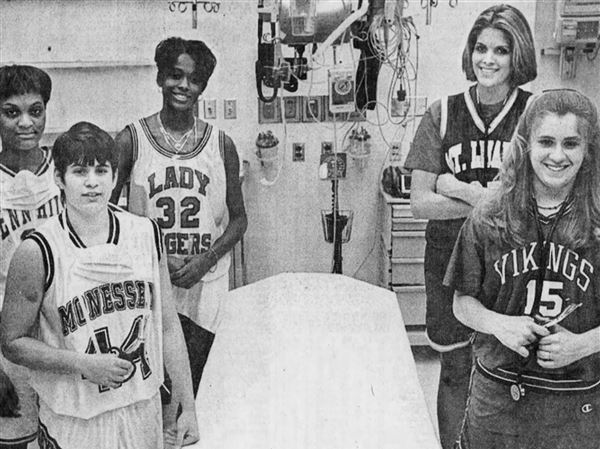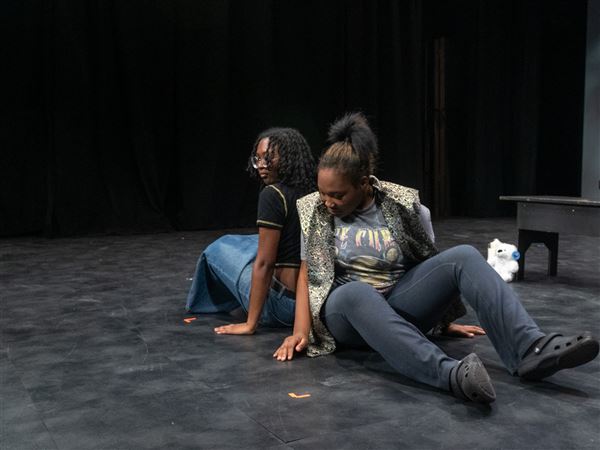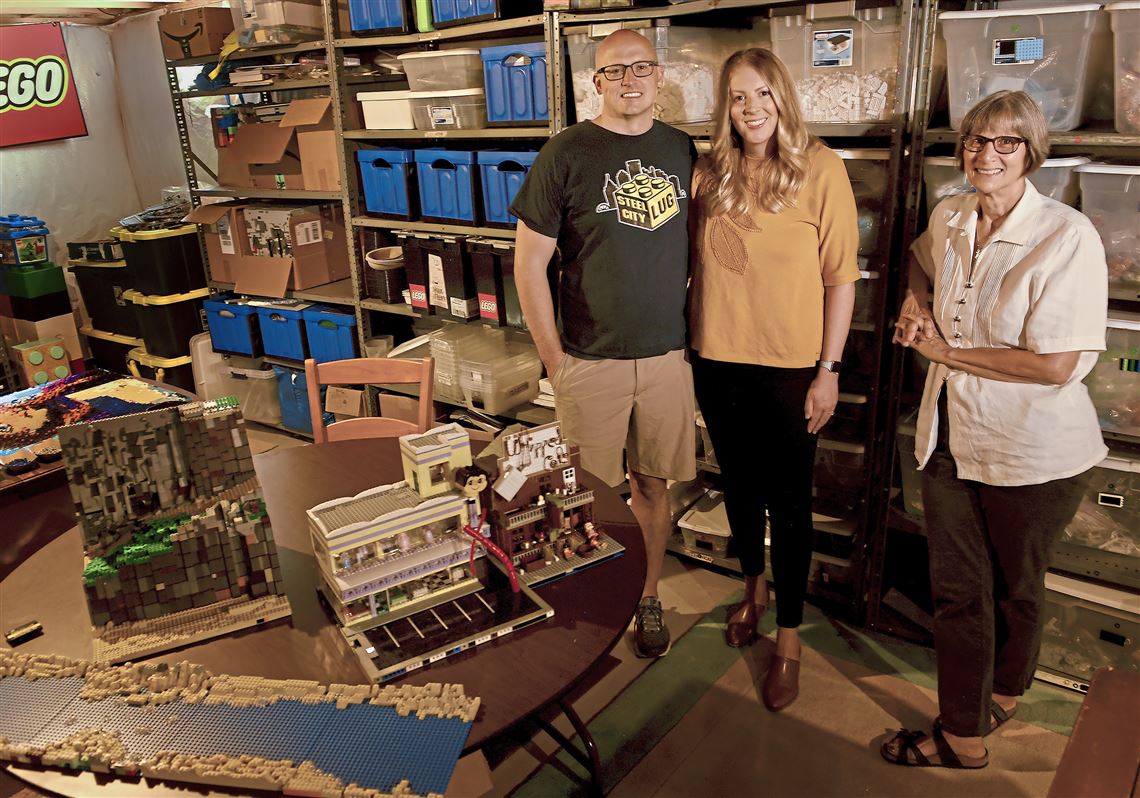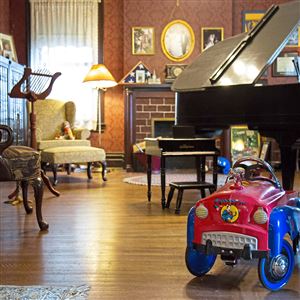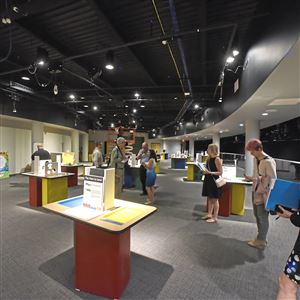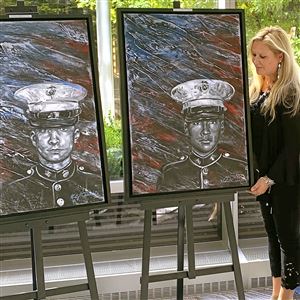Amanda Edmondson had dated Josh Hall for about two months when she first traveled from her Kentucky home to his in Bethel Park.
Along with showing her around Pittsburgh and other first-visit to-dos, Mr. Hall introduced her to his friends. Disaster could have struck when three separate friends pulled her aside and whispered, “Have you seen his basement yet?”
But Ms. Edmondson just laughed because she had: Her boyfriend’s spacious basement was full of boxes and bins of Legos.
“I just saw it as a creative outlet, as an art form,” now-Mrs. Hall said. “The way he talks about it, and based on the pieces he showed me, it’s very much an art.”
Mr. Hall is the founder of Steel City Lego User Group, which is officially recognized by the Denmark-based company. The group just passed its ninth year in existence and is in high demand for public displays. Quarterly meetings help them stay organized, and other get-togethers allow them to build as a group.
In its simplest form, Steel City LUG is a group of adults with a shared interest. But a closer look reveals modes of interaction, credos, distinct roles and a unique list of colloquialisms that make the hobby more of a society whose culture is based on bricks.
‘Get it out of my house’
Mr. Hall remembers, starting when he was about 8, staring down aisles of Legos at the Toys R Us near his California, Pa., childhood home. It was before licensed Star Wars or Indiana Jones sets. The big sought-after boxes were simply space- or pirate-themed, with flaps that opened to reveal hundreds of bricks inside.
With an engineer father and a natural interest in architecture, he loved Legos. He played with friends, traded sets and crafted his own pieces when the directions got boring.
But at around age 12, he became more interested in baseball and basketball, playing his guitar, and girls — the “dark ages,” in LUG terminology. He shoved his collection in a 50-gallon plastic tub and forgot about it. But his mom didn’t.
When he purchased his first home in 2006, she asked that he take his old stuff out of her house, which reignited his interest.
He clawed through the bricks, sifting out some old favorites, such as custom mini-figures and rare “Blacktron” space figures, which he set aside on his coffee table. “Now what am I going to do with them?” he wondered. Next he separated the bricks by set. Then he made a tractor with a spinning mowing deck.
His favorite parts “would spark an idea and a memory,” which led him to post pictures of the creations onto his personal blog. Then, the hobby “snowballed” in 2012.
The Montour School District took notice of his blog and asked if he knew of anyone who could teach a Lego class to some elementary school kids, and he nominated himself for the job. Next came a building competition at S.W. Randall Toyes and Giftes store in Squirrel Hill, where he built a contest-winning Cathedral of Learning.
Random Lego-related internet searches led him to discover terms like Adult Fans of Lego (AFOLs) and LUG — signs of other adults like him.
There are now 300 or 400 LUGs around the world, but the only one in Pennsylvania at the time was PennLUG in Philadelphia. Predictably, it had no consistent Pittsburgh members.
Giving Mr. Hall an introduction to the collaborative, encouraging nature of AFOL, PennLUG members helped him apply and gain recognition by Lego for his own group in Pittsburgh.
With 15 original members, he founded Steel City LUG in August 2012.
Everything, and everyone, in their place
Mr. Hall just finished a Lego room in his basement for his daughters, Juliette, 9, and Maddie, 7, who are “fully immersed” in the hobby. There are black lights and a custom table with a “gutter rim” meant to quickly stow the bricks or catch them before falling to the ground.
The larger part of the basement is where the grown-ups play.
The walls are lined with floor-to-ceiling shelving units, each one covered with plastic containers or original Lego boxes full of the “LUG inventory of parts,” or the ones shared by the group. On the front of each plastic bin is a photo of the type of pieces it contains. How they got there often hinges on one specific member, Nancy Flury Carlson.
The 67-year-old former corporate/technical librarian for Westinghouse Electric Co. is, in a way, a professionally trained sorter. Even now, as a member of the LUG, it’s her favorite task.
“It’s kind of just like noodling around,” she said. “It’s like people who really like to clean and get every nook and cranny in their house clean. That’s not me, but I like to clean up all the Lego.”
As an officially recognized LUG, the group receives “LUG Bulk,” which are mass quantities of Legos sold at a discounted rate. There’s one catch: They aren’t sorted. But that doesn’t bother Ms. Carlson.
Sorting through Legos reminds her of building with her now-adult son. He, too, liked his Legos mixed in a heap. The jumble also reminds her of an abstract painting class in college from which the phrase “order out of chaos” sticks in her head.
“It’s a way of accessing your memories that you wouldn’t think of otherwise,” she said. “I love the sorting. That’s just my little niche, and I’m happy to do it for them if they find it helpful.”
What clicks
Although Ms. Carlson doesn’t care to build with the group, she marvels at those who do, especially when they specialize.
Some are known for themed builds, like all space creations or trains and trucks. But other Lego identities are more conceptual.
After nine years at the helm of Steel City LUG, Mr. Hall notices that many builders regard themselves as artists, with Legos as their medium. Others are attracted to the group for their love of collecting and an attempt to gather as many Lego sets, or rare brick shapes or colors, as possible. Another draw is storytelling, like the elaborate narratives that accompany builds on the Fox competition reality show “Lego Masters,” for example. But that facet escapes Mr. Hall.
“That is totally a part of the hobby that I miss,” he said. “But I love that storytelling is a part of ‘Lego Masters’ because it validates that part of the hobby.”
Another analytical member of the group — and someone who represents the engineering allure of Lego — is Micah Beideman, a senior engineering student at Robert Morris University.
In 2018, the University of Pittsburgh contacted Mr. Hall to ask if the LUG could create a Pitt logo on “heroic scale.” Mr. Hall agreed and consulted with the group. Knowing it would be a feat of engineering, Mr. Beideman used the experience as his summer internship.
Using Lego design software, the group determined the creation should stand about 3 feet wide, 6 feet tall and 10 feet long, which would require about 200,000 bricks.
“There were aspects of structural engineering when you’re building something that big,” he said. “We had to design a steel frame that went on the inside of it and find ways to build it so it wouldn’t fall apart, since it’s over 1,000 pounds.”
The Pitt logo still stands in the lobby of the Petersen Events Center at Pitt’s Oakland campus and on Mr. Beideman’s resume, which he’s sending out regularly in anticipation of his December 2021 graduation.
‘That’s what I’ve learned’
New Steel City LUG members take an oath that echoes Mr. Hall’s Lego purist mentality: “I (state your name) do solemnly swear to build with the whole Lego element. No cutting. No modifying a brick. No adding stickers. No painting,”
“If this is art and we’re sticking to a medium, we’ll all have the same medium in common,” Mr. Hall said. “When you start modifying things, you could just use popsicle sticks or whatever you want.”
After taking the oath, they enter a world where terms such as SNOT (bricks with Studs Not On Top), POOP (Pieces Out of Pieces, which come with less advanced sets), BURPs (Big Ugly Rock Pieces) and LURPs (Little Ugly Rock Pieces) are used without giggles.
And there’s a culture of encouragement between members, something Mrs. Hall notices easily as an “outsider.”
“If you take the corporate world or a company, there’s going to be some level of drama or competitiveness,” she said, leaning on her experience as a media relations professional. “But they’re collaborating on different builds and sharing skills and techniques, always looking to better the person, which is not always normal in our society.”
Despite a mutual interest in Lego, the group is hugely diverse: different ages, genders, stages of life and professions. With so much of their identities anchored in those other aspects of life, it’s easier for them to unselfishly unite — or “click” — over their builds, suspects Mrs. Hall. But she’s still learning.
“Coming from Kentucky, I would say a distillery master is a purist for a type of bourbon,” she said. “I would say [LUG members are] purists for their trade in the sense of never knock-off pieces, always Lego. It’s not ‘Legos.’ It’s ‘Lego.’ And they’re ‘bricks.’ Those are the things I’ve learned.”
Abby Mackey: amackey@post-gazette.com, Twitter @AnthroAbbyRN and Instagram @abbymackeywrites.
First Published: October 8, 2021, 10:00 a.m.
Updated: October 8, 2021, 2:11 p.m.
